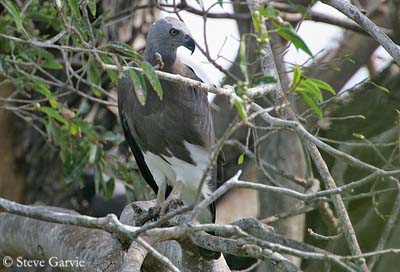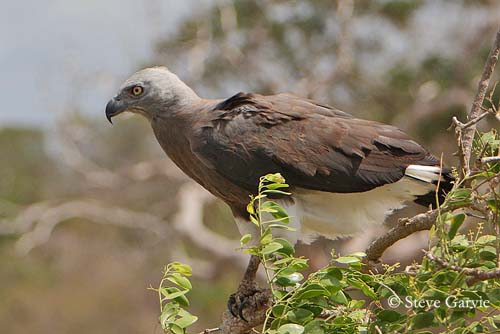
Grey-headed Fish Eagle - Ichthyophaga ichthyaetus
Accipitriforme Order – Accipitridae Family
BIOMETRICS:
Length: 61-75 cm
Wingspan: 155-170 cm
Weight: 1600-2700 g
DESCRIPTION :
Grey-headed Fish Eagle is an elegant raptor living around aquatic habitats, as all the fish-eating eagles.
PROTECTION / THREATS / STATUS:
Grey-headed Fish Eagle may be relatively common in some regions of the range, but this species is threatened by habitat loss, over-fishing, siltation, pollution and even persecution.
Grey-headed Fish Eagle is classified as Near Threatened.
Fr: Pygargue à tête grise
All : Graukopf-Seeadler
Esp: Pigarguillo Común
Ital: Aquila pescatrice testagrigia
Nd: Grote Rivierarend
Russe: Орлан-Рыболов
Photographs by Steve Garvie
RAINBIRDER Photo galleries
Text by Nicole Bouglouan
Sources :
HANDBOOK OF THE BIRDS OF THE WORLD Vol 2 by Josep del Hoyo-Andrew Elliot-Jordi Sargatal - Lynx Edicions - ISBN: 8487334156
BirdLife International (BirdLife International)
Wikipedia (Wikipedia, The Free Encyclopedia)

Adult male has dark brownish-grey wings and upperparts. Tail is white with broad black terminal band.
Underparts show slightly paler brownish-grey breast and upper belly. Lower belly, thighs and undertail coverts are white. Undertail feathers are white with black terminal band. Underwing is dark grey-brown.
The small head is greyish.
The hooked bill is grey, darker at tip. Eyes are pale yellow. Legs and feet are grey-brown with black claws.
Both sexes are similar.
Juvenile is pale buff to brown. Underparts are heavily streaked white.
Grey-headed Fish Eagle is darker than the very similar but smaller Lesser Fish Eagle (Ichthyophaga humilis).
VOICE: SOUNDS BY XENO-CANTO
Grey-headed Fish Eagle is vocal during the courtship displays, and mostly silent outside breeding season. Calls are heard in the morning and in the evening. They are similar to a cross between a laugh and a scream.
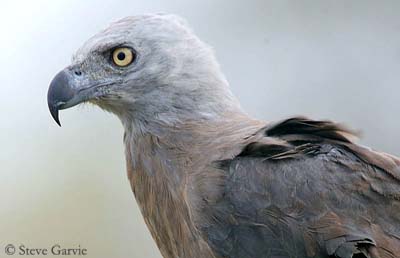
HABITAT:
Grey-headed Fish Eagle frequents lowland forests close to fresh waters, streams, large ponds, rivers, marshes… This eagle may be found along sea coasts and near estuaries. It may be seen locally up to 1500 metres of elevation.
RANGE:
Grey-headed Fish Eagle is sedentary and breeds in southern Asia, from India and Sri Lanka to south-east Asia and Philippines.
BEHAVIOUR:
Grey-headed Fish Eagle feeds almost exclusively on fish, caught with the talons while flying over the water surface. It watches for prey from a perch close to the water.
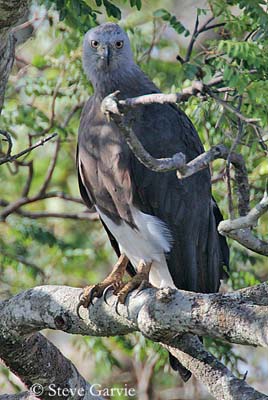
Then, it dives down with a short flight with legs and talons held forwards, and then, it grabs the fish in a great swoop.
The eagle usually carries the fish to the perch for eating it. But if the prey is too big, it drags the fish to the shore.
Grey-headed Fish Eagle also takes dead fish, small birds and mammals. This species usually takes fish near the water surface and it does not submerge its body, only legs and feet.
Then, the fish or other prey is eaten on a branch and torn to pieces with the hooked bill.
The Grey-headed Fish Eagle hunts mainly in open waters. The large wings allow it to soar and glide easily, and to rise with the prey. It does not dive into the water as other species.
The nuptial behaviour is not known at this moment.
FLIGHT:
Grey-headed Fish Eagle has long, broad wings allowing easy soaring and gliding. It performs powerful wing beats to rise above the water with the prey.
REPRODUCTION:
Breeding season varies according to the range.
Grey-headed Fish Eagle nests in forest near water, lakes or streams.
This species usually reuses the same nest year after year. The huge nest is made with sticks, and situated in tall tree, between 10 and 30 metres above the ground.
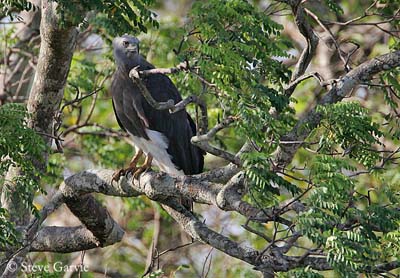
Female lays 1-2 eggs, sometimes three. Incubation lasts about one month, shared by both adults. Young are fed by parents, and fledge about ten weeks later.
The food-dependency period is unknown.
DIET:
Grey-headed Fish Eagle feeds mainly on fish, dead or alive, but it also catches small birds and mammals.
It hunts from a perch and when the prey is detected by sight, the eagle takes off rapidly, flies over the surface and grabs the fish behind the head with the long, curved claws.
